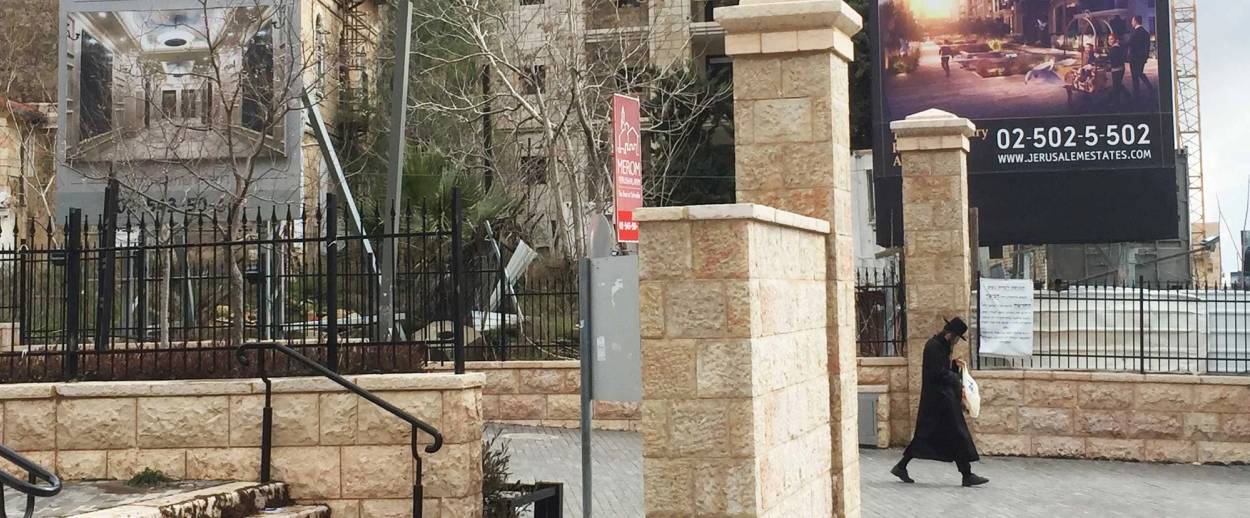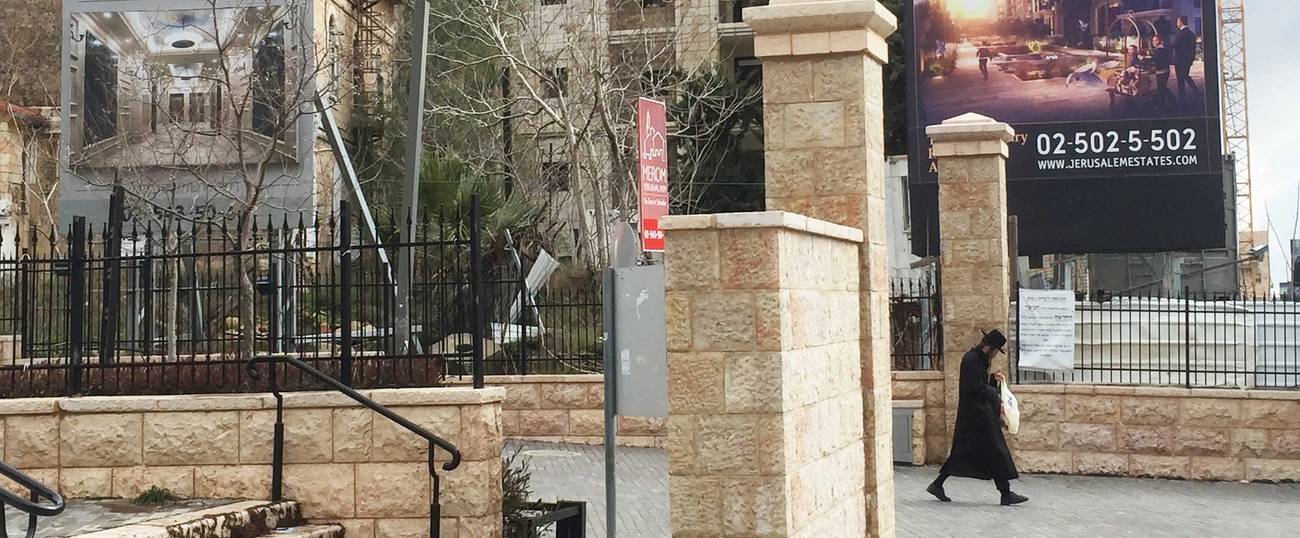Jerusalem’s Haredim: Moving on Up
New luxury apartments target the ultra-Orthodox




In the center of Jerusalem, in a walled-off and abandoned historic orphanage and former military compound, several new apartment buildings are rising. Sleek aluminum-encased wooden window frames, imported from Italy, hint at the modern and luxurious character of these high-rise stone buildings that make up the Jerusalem Estates project.
In addition to apartments, the complex will include a sprawling private park, a synagogue, a wine cellar, and an art museum, incorporating several restored 150-year-old structures. The same architects who designed some of the city’s most upscale projects—including the Waldorf Astoria Jerusalem, built partly from the remains of an antique palace; and the Orient Jerusalem, comprising several revamped German Templer houses—are also behind this project, which advertises itself on its website to prospective buyers who want “an updated high-end lifestyle.” But it’s also clear from the advertising materials that it’s not just the price—about $1 million for a three-bedroom apartment—that will determine who lives here.
“It appeals to anyone who yearns for a place where the shechina is omnipresent,” the project’s website says. At the site itself, a large billboard shows off a rendering of the lush interiors of the future lobbies including a man dressed in the typical ultra-Orthodox garb of a long black coat and hat strolling the area’s future park with a group of children. There are no photos of women in the advertising materials, making it clear this is a project intended for Haredi residents. “It is for people who have the melodies of Jerusalem etched in their hearts, who consider the acquisition of property in the holy city as a fulfillment of a vision and a life-long yearning, and who wish to take advantage of this prized opportunity to be part of such an elite community,” the site says.
Although Jerusalem Estates stands out for its sheer size and historical character, it is just one of many new luxury housing projects changing the character of the city’s traditional ultra-Orthodox areas. The streets of neighborhoods that are essentially completely ultra-Orthodox and home to some of the most revered yeshivas and Hasidic leaders—places like Romema, Geulah, Mekor Baruch, and Shaare Hesed—are now filled with construction cranes busy building expensive and exclusive new residential buildings aimed at very religious residents.
“We see more Haredi clients looking for luxury,” said Chani Chen, a real estate agent at Remax-Vision, which recently opened a branch office in Romema—the company’s first location in an ultra-Orthodox area—to better serve those customers. “This lifestyle is going up in general. For many, it’s no longer enough that the apartment itself is very good, but the building itself must have things like a doorman, a business center, gyms.” These new high-end Haredi projects come amid an overall hot housing market, increased construction in Jerusalem compared to previous decades, and growing wealth among some parts of ultra-Orthodox society, especially immigrants from abroad.
“It’s quite natural,” said David Kroyanker, an architect and architectural historian of Jerusalem. “There is no reason that Haredi families who can afford it can’t live in these new high-rises.”
Although Jerusalem’s—and Israel’s—housing market has been booming for more than a decade, prices have been rising even more sharply in ultra-Orthodox areas, according to research by the Bank of Israel. This is due to rapid population growth and to the fact that ultra-Orthodox Jews almost always prefer to live in ultra-Orthodox areas, explained Adi Finkelstein, a researcher at the bank who authored the report.
In areas that experience an influx of Haredi residents, housing prices also go up fast, Finkelstein found, explaining that his data show that a 1% increase in the number of households who vote for ultra-Orthodox parties was accompanied by an extra 0.8% increase in housing prices. Eager to capitalize on these higher prices and strong demand, real estate developers have turned their efforts toward the Haredi market.
“They are beginning to pay attention and increase the quality of projects in these areas,” said Kim Bash, a real estate agent at T&T Jerusalem. Such developers include balconies fit for building sukkot, and install two sinks in the kitchen; they make kitchen surfaces out of materials that can be kashered, like stainless steel, and make sure the Shabbat elevators meet strict religious standards, she said. Some buildings also include mikvahs. On Jaffa Road, near the city’s Mahane Yehuda outdoor market, the 23-story Saidoff Tower includes a pool with separate swimming hours for men and women, hinting at its religious clientele. Projects like the nearby 14-story Shalem Tower advertise their proximity to “Torah institutions.”
Many of the buyers in the new projects oriented at a very religious population are from overseas, often from the United States and France, Bash said. “Developers know this market won’t take shabby construction.”
In addition to new high-rises, other signs of wealth are popping up in these areas.
In Romema, a large ultra-Orthodox neighborhood that borders the Jerusalem Estates project, new shops and restaurants have also opened among the new high-rise luxury buildings.
“It’s really building up now, with more places to go, things to do,” said Pearl, a 22-year-old from London who is living in Romema for a few years while her husband attends yeshiva. The couple, who have two young children, appreciate the area’s changes and the growing number of English-speakers here. “But the price to rent a nice place is high,” said Pearl, who did not want to give her family name. The average purchase price for an apartment in Romema is now 2.3 million shekels ($666,000), up from 1.3 million shekels ($376,000) a decade ago, according to the Israeli real estate site Madlan. Data from the Israel Democracy Institute show that other economic aspects of Romema have changed; the percentage of adults from the neighborhood participating in the workforce had increased to 59.5% by 2017, up from 53.8% in 2013. The median annual salary also grew to 71,551 shekels ($20,766) in 2017, up from 59,572 shekels ($17,290) in 2013.
The higher prices and other facets of the area’s changing character worry many.
In nearby Mekor Baruch, signs advertise a new seven-building complex that will be built along the narrow Takhemoni Street, where most of the current buildings are no more than a few stories tall.
“It will mean more traffic,” said Yehezkal Green, 48, who grew up here and still lives in the area. He was taking a break from religious learning to drink a coffee in a small shop selling lottery tickets and some grocery items. “More tall buildings are also problematic because it means Shabbat elevators, which not everyone will use for religious reasons. And in the religious world, the most important thing should be if your house is clean and organized, not how fancy or tall it is.” He said the fact that his family’s simple apartment has grown in value doesn’t make up for the changes: “We don’t want to sell it and move, so it really doesn’t matter how much it is worth.”
Overall, Haredim in Israel are still much poorer than the rest of the Jewish public, and many cannot afford to buy or even rent apartments in Jerusalem, said Eitan Regev, an economist and research fellow focusing on ultra-Orthodox society at the Israel Democracy Institute, a think tank in Jerusalem. This has resulted in many young ultra-Orthodox families leaving the city, he said, moving to the south or north. Nechami, a 20-year-old who works at Kitchens, a store in Romema that sells and designs kitchen interiors and appliances, says she will probably not be able to afford to stay in this neighborhood, where she grew up and where her parents have an apartment. For now, she still lives with her parents, but imagines that after she is married she will join her married sisters in Beit Shemesh, where property prices are significantly lower. “I want to stay here, because it’s so central and is developing so nicely now with so many new shops and restaurants,” she said, “but it’s probably just not possible.”
Such migration trends also mean that ultra-Orthodox society in Jerusalem will become increasingly wealthy, Regev said. “Jerusalem is becoming a place, especially for Haredim, that only rich people can afford,” he said. “So it will be not only a city of the spiritually elite of Haredi society, as it has been for generations, but also for the economically elite of the society.” On the one hand, that is good economically for the city, he said. But it also means there are a growing number of ultra-Orthodox living in the city in subpar conditions, including in divided apartments, storage units, and converted garages—many of them not legal or up to building code standards—because they cannot afford to buy or rent a regular apartment, he said.
“We are seeing the development, literally, of an upper city and a hidden lower city,” Regev said.
Meanwhile, demand is growing in both, he said. And with cranes filling the skyline, Jerusalem’s historic ultra-Orthodox areas are on course to look much more upscale, at least from the outside.
“People may have been afraid before what others would think if they moved to a luxury building,” Chen said. “But this is becoming more socially acceptable and more and more people will do it.”
Sara Toth Stub is a Jerusalem-based American journalist who has written for The Wall Street Journal, Dow Jones Newswires, Associated Press, and other publications.